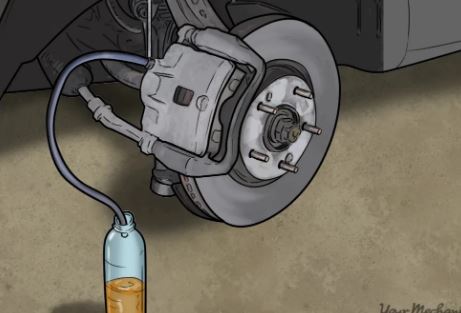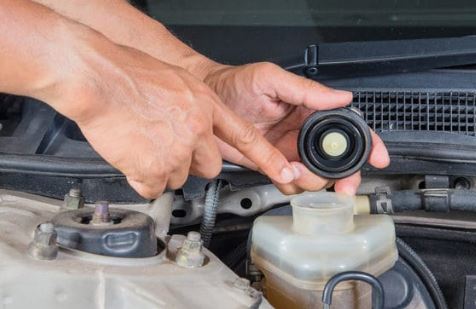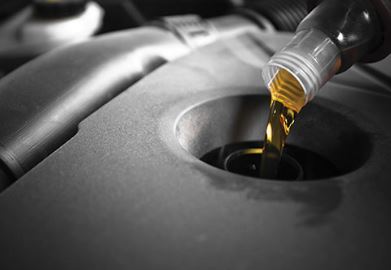If you’re a vehicle owner, you know how important brake fluid is for the safe and smooth operation of your vehicle’s braking system. But what happens when you need to dispose of brake fluid? Improper disposal of brake fluid can have serious environmental and legal consequences. That’s why it’s essential to know how to dispose of brake fluid properly. In this, we’ll provide you with a comprehensive guide on everything you need to know about how to dispose of brake fluid, including the various methods of disposal, legal requirements, and how to find disposal facilities.
What is Brake Fluid

Brake fluid is a type of hydraulic fluid that is used in modern automotive braking systems. It is a critical component of the braking system, as it transfers force from the brake pedal to the brakes themselves, enabling the vehicle to slow down or come to a stop.
It is typically a clear or light-yellow color and has a high boiling point in order to withstand the high temperatures generated during braking. It is also formulated to be resistant to water absorption, as moisture can cause corrosion and reduce the effectiveness of the braking system.
There are several types available, including DOT 3, DOT 4, and DOT 5.1. Each type has its own specific properties, and it is important to use the type recommended by the vehicle manufacturer in order to ensure proper brake system operation.
It should be checked regularly and replaced as needed, as it can become contaminated over time and lose its effectiveness. It is also important to handle this fluid carefully, as it can be corrosive and toxic if ingested.
Why Proper Brake Fluid Disposal Matters

Proper brake fluid disposal matters because it is crucial for both human health and the environment. Brake fluid is a toxic chemical that can cause severe harm to human health if it is not disposed of safely and responsibly. It contains a mixture of glycol ethers and polyglycerols, which can cause skin and eye irritation, respiratory problems, and even central nervous system depression if ingested.
Improper brake fluid disposal can also cause environmental harm. Brake fluid is not biodegradable, which means it can persist in the environment for a long time, contaminating soil and water supplies. It can also leach into groundwater, harming aquatic life and posing a risk to human health. In addition, improperly disposed of brake fluid can also lead to legal consequences, as many countries have laws that prohibit the disposal of toxic chemicals in regular trash.
By following safe and responsible brake fluid disposal practices, we can protect ourselves, our communities, and the environment from the negative effects of this hazardous substance. We can minimize the risk of accidents and exposure, prevent pollution, and promote sustainable waste management. Proper brake fluid disposal is not just a matter of compliance with the law; it is a responsibility that we all share in safeguarding our health and the planet.
How to Dispose of Brake Fluid: Steps

- Determine whether the brake fluid is contaminated or not. If it’s not contaminated, you can dispose of it with other households hazardous waste. If it is contaminated, it requires special handling and should be taken to a hazardous waste facility.
- Locate a hazardous waste facility in your area. You can check with your local government or waste management agency for a list of approved hazardous waste facilities.
- Store the brake fluid in a safe and secure container that is specifically designed for hazardous waste. Ensure that the container is sealed tightly to avoid spills and leaks.
- Transport the container to the hazardous waste facility using a vehicle that is in good condition and can safely carry hazardous waste. Ensure that the container is securely fastened and upright during transportation.
- Follow the guidelines provided by the hazardous waste facility for disposing of the brake fluid. They may require you to fill out forms or pay a fee for proper disposal.
- Once you have disposed of the brake fluid, wash your hands thoroughly with soap and water. Avoid contact with your eyes, mouth, and skin when handling hazardous waste.
How to Store Brake Fluid Before Disposal
- Keep the brake fluid in its original container: It should be stored in its original container with a tight-fitting cap. This will prevent any contamination from air, water, or other substances.
- Store the container in a cool and dry place: It should be kept away from direct sunlight and high temperatures, as this can cause it to deteriorate and lose its effectiveness. A cool and dry place, such as a garage or storage room, is ideal.
- Keep the container upright: The container should be kept upright to prevent any leakage or spills.
- Label the container: Clearly label the container as “brake fluid” and indicate the date it was stored. This will help you keep track of when it was stored and ensure that it is properly disposed of in a timely manner.
- Keep it out of reach of children and pets: This fluid is toxic and can be harmful if ingested. Make sure to store it in a location that is inaccessible to children and pets.
Brake Fluid Disposal Methods
- Recycling: This is the most environmentally friendly method of disposing of. Many auto parts stores and recycling centers accept used brake fluid for recycling. The fluid is cleaned, filtered, and reprocessed into new fluid or other products.
- Professional disposal: Some waste disposal companies offer professional brake fluid disposal services. They have the equipment and expertise to handle hazardous materials safely and responsibly.
- Household hazardous waste collection: Many cities and counties have household hazardous waste collection programs that allow residents to dispose of hazardous materials like brake fluid. Check with your local government to see if such a program is available in your area.
- Evaporation: This method involves pouring the brake fluid into a container and leaving it in a well-ventilated area to evaporate. However, this method is not recommended as it can release harmful vapors and may contaminate the air and soil.
- Landfill disposal: This is the least desirable method of disposing of fluid. If no other disposal options are available, the brake fluid can be taken to a licensed hazardous waste landfill for disposal. However, this should be a last resort as it can cause long-term environmental harm.
Brake Fluid Recycling and Reusing Options

- Filtering and reusing: If the brake fluid is only slightly contaminated, it can be filtered using a special filtration system and reused. This process can be done multiple times, as long as the fluid remains within acceptable levels of contamination.
- Recycling: There are companies that specialize in recycling brake fluid. They use specialized equipment to remove contaminants and restore the fluid to its original quality. The recycled fluid can then be used in other vehicles or sold to manufacturers.
- Disposing: If the fluid is too contaminated to be reused or recycled, it must be disposed of properly. It is considered hazardous waste and must be disposed of according to local regulations. Contact your local waste management facility to determine the proper disposal method.
- Donating: If you have unused, unopened fluid that you no longer need, consider donating it to a local auto repair shop or automotive program. They may be able to use it for training purposes or to help customers who can’t afford new brake fluid.
Legal Requirements for Brake Fluid Disposal
- It must be disposed of in accordance with all applicable federal, state, and local regulations.
- It must be properly labeled and stored in a secure container that is designed to prevent leaks and spills. The container must be labeled as hazardous waste and include information such as the contents, date of accumulation, and generator information.
- It must not be mixed with other hazardous wastes or non-hazardous wastes.
- The disposal of this fluid must be handled by a licensed and permitted hazardous waste disposal facility.
- In some states, generators of hazardous waste, including this fluid, may be required to obtain a permit or notify regulatory agencies before disposing of the waste.
- Transportation of it for disposal must comply with all applicable transportation regulations.
- Companies that generate significant quantities of hazardous waste, including this fluid, may be required to file reports with regulatory agencies.
- Companies that violate hazardous waste disposal regulations may face significant fines and penalties.
FAQs About How to Dispose of Brake Fluid
Can brake fluid be reused?
No, it cannot be reused once it has been removed from the vehicle’s braking system. The quality of fluid deteriorates over time, even if it is stored properly.
How often should brake fluid be changed?
It should be changed every two to three years or as recommended by the vehicle manufacturer. If you notice any signs of contamination or degradation, such as a change in color or texture, it’s essential to have the change immediately.
What happens if I dispose of brake fluid improperly?
Improper disposal of this fluid can have severe environmental consequences, including contamination of soil and water sources. It can also lead to legal consequences, such as fines and penalties for non-compliance with local regulations.
Can brake fluid be thrown in the trash?
No, it should never be thrown in the trash. It is considered hazardous waste and must be disposed of properly.
Are there any DIY methods that are safe and legal for brake fluid disposal?
No, there are no safe and legal DIY methods for brake fluid disposal. The only safe and legal way to dispose of this fluid is to take it to a certified disposal facility that can handle hazardous waste properly.
Final Thought
In the end, knowing how to dispose of brake fluid is essential for protecting the environment and avoiding legal consequences. This fluid can be harmful to the environment and requires proper disposal procedures. It is important to follow federal and state regulations, transport brake fluid safely, and locate an appropriate disposal facility. DIY methods should only be used as a last resort and should be safe and legal. Brake fluid recycling and reuse options should also be considered when possible. By properly disposing of it we can ensure the safety of our environment and communities.
Related Topics:
- What Can I Use Instead of Brake Fluid
- brake fluid low but no leak
- How Long Can You Drive Without Brake Fluid
- No Brake Fluid to One Wheel
- can you add brake fluid while car is hot
- Brake Fluid Leaking from Caliper Bolt
- what happens when brake fluid is low
- When to Flush Brake Fluid
- Does Brake Fluid Leak When Car is Off
- How to Dispose of Brake Fluid


